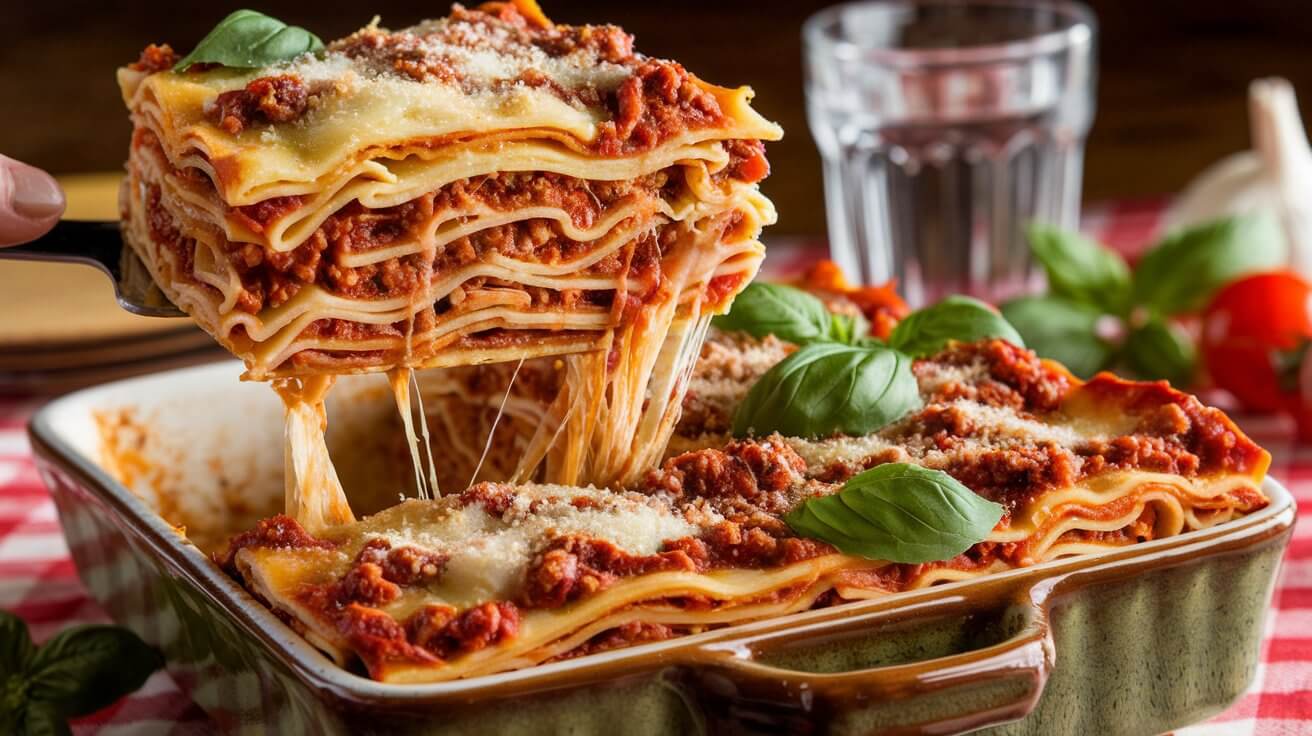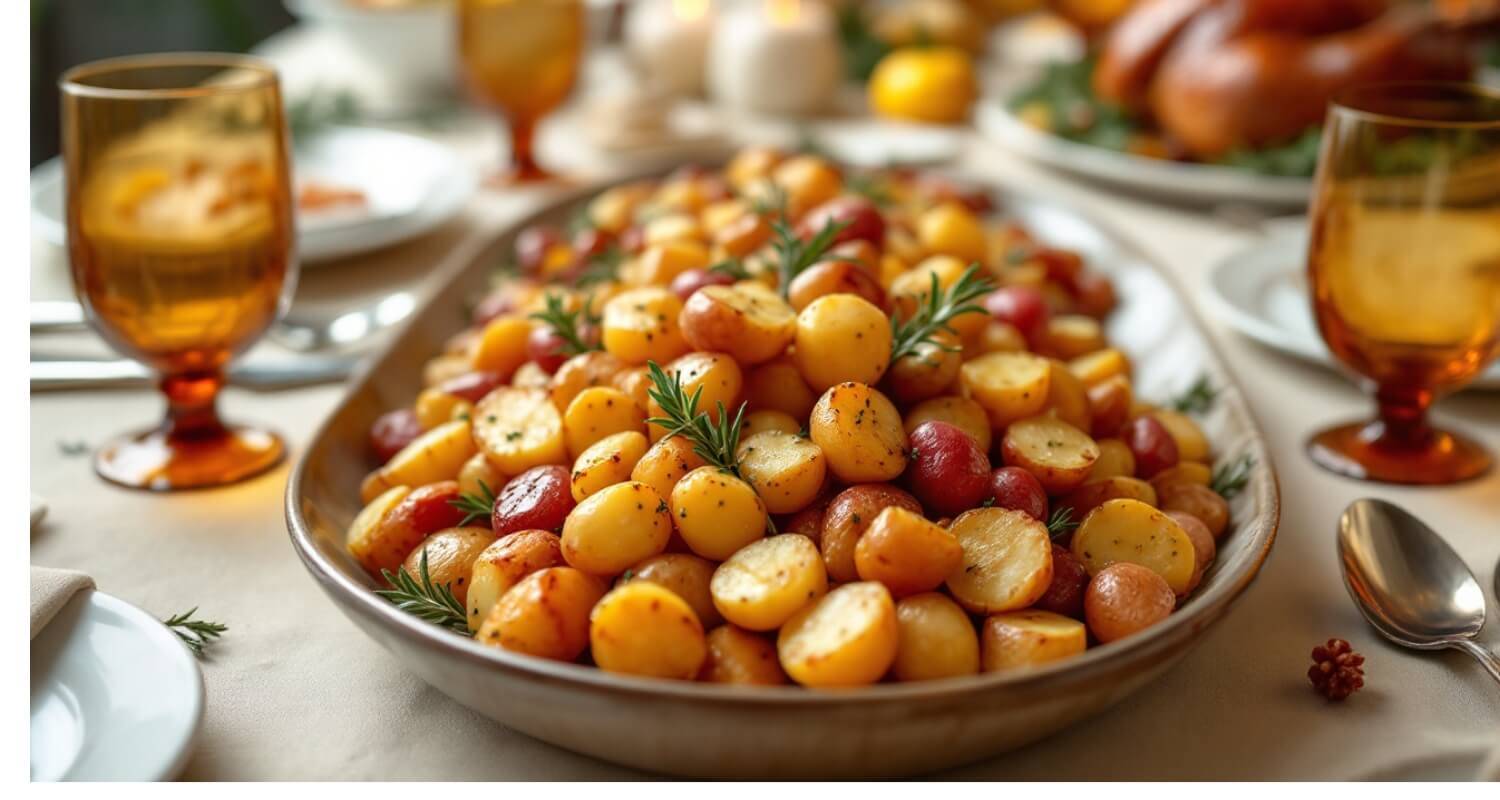Ultimate Lasagna Mastery: 14 Pro Secrets for Perfect Layers (2025 Guide)

Table of Contents
Introduction
Lasagna, a beloved Italian pasta dish, has captured the hearts and taste buds of food lovers around the world. This comprehensive guide will take you on a culinary journey through the rich history, diverse variations, and expert techniques for creating the perfect lasagna. Whether you’re a seasoned chef or a kitchen novice, this article will provide you with everything you need to know about this iconic dish.
From its humble beginnings in ancient Rome to its status as a global comfort food favorite, lasagna has evolved into a versatile and beloved meal. In this guide, we’ll explore the traditional recipes, modern twists, and everything in between, ensuring you have all the knowledge needed to create the best homemade lasagna.
The Origins and Evolution of Lasagna
Ancient Roman Roots
The history of lasagna stretches back to ancient times. The Romans had a dish called “lasanum,” which referred to a cooking pot. This eventually evolved into “lasagna,” describing the food cooked in such a pot. Early versions of layered pasta dishes can be traced to ancient Rome, though they differed significantly from the lasagna we know today.
Development in Medieval Italy
During the Middle Ages, lasagna began to take shape in Italy. The first recorded recipe resembling modern lasagna appeared in a 14th-century cookbook from Naples. This early version featured fermented dough and was often sweetened with sugar and spices, a far cry from the savory dish we enjoy today.
Modern-day Lasagna
As tomatoes were introduced to Italian cuisine in the 16th and 17th centuries, lasagna evolved into something closer to its current form. The addition of tomato sauce, along with the incorporation of cheese and various meats, transformed lasagna into the rich, flavorful dish that has become a global favorite. Today, lasagna is recognized worldwide as a comforting, hearty meal that brings families together around the dinner table.
Traditional Italian Lasagna
Authentic Lasagna al Forno
“Lasagna al forno,” or oven-baked lasagna, is the classic Italian version of this dish. It typically consists of layers of fresh pasta sheets, Bolognese sauce (a meat-based sauce originating from Bologna), béchamel sauce, and Parmigiano-Reggiano cheese. This combination creates a perfect balance of flavors and textures that has stood the test of time.
The key to authentic lasagna al forno lies in the quality of its ingredients and the patience in its preparation. The Bolognese sauce, for instance, is often simmered for hours to develop a deep, rich flavor. The béchamel sauce, made from butter, flour, and milk, adds a creamy texture that binds the layers together.
Regional Variations in Italy
While lasagna al forno is widely recognized, Italy boasts numerous regional variations, each reflecting local tastes and ingredients:
- Lasagna alla Napoletana: Popular in Naples, this version uses mozzarella, ricotta, and small meatballs. It’s often prepared for special occasions and holidays.
- Lasagne Verdi: Hailing from Emilia-Romagna, this variation features spinach pasta sheets, giving the dish a distinctive green color and earthy flavor.
- Vincisgrassi: A variation from Le Marche, including mushrooms and prosciutto. This luxurious version often incorporates truffle for an extra layer of flavor.
- Lasagna Bianca: Common in northern Italy, this “white lasagna” omits tomato sauce, instead relying on béchamel, cheese, and sometimes vegetables for its layers.
These regional variations showcase the versatility of lasagna and how it has been adapted to suit local tastes and ingredients across Italy.
Anatomy of a Perfect Lasagna
Creating the best lasagna requires understanding its key components. Each element plays a crucial role in the overall taste, texture, and structure of the dish.
Lasagna Noodles
Traditional lasagna uses wide, flat pasta sheets, often with wavy edges. These can be fresh or dried, with fresh pasta offering a more delicate texture. Some modern recipes use no-boil noodles for convenience, though traditionalists often prefer the texture of freshly made pasta.
The choice of noodles can significantly impact the final dish:
- Fresh pasta: Offers a tender texture and can absorb sauces well.
- Dried pasta: More readily available and can hold up well to hearty sauces.
- No-boil noodles: Convenient but may absorb more liquid from the sauce.
Lasagna Sauce
The sauce is crucial to a great lasagna. Classic recipes use either a meat-based ragù or a tomato sauce. The sauce should be thick enough to coat the pasta without making the dish watery.
Common sauce types include:
- Bolognese: A meat-based sauce that’s rich and flavorful.
- Marinara: A simple tomato-based sauce for vegetarian options.
- Béchamel: A white sauce that adds creaminess and binds layers together.
Lasagna Cheese
A combination of cheeses provides flavor and texture. Common choices include:
- Ricotta: For a creamy layer that adds richness.
- Mozzarella: For stretch and melt, creating that classic cheese pull.
- Parmigiano-Reggiano: For sharp, salty flavor that enhances overall taste.
Meat and Vegetable Fillings
Traditional meat lasagna uses ground beef or a combination of meats. Vegetarian versions might include spinach, zucchini, or eggplant. The fillings add substance and flavor to the dish.
The Importance of Layers
Proper layering is key to lasagna’s structure and flavor distribution. A typical lasagna has 3-4 layers, but some recipes go up to 6 or more. Each layer should be evenly spread to ensure consistent texture and taste throughout the dish.
How to Make Lasagna: Step-by-Step Guide
Preparing the Ingredients
- Make the sauce (ragù or tomato-based):
- For meat sauce, brown ground beef or a mix of meats, then add tomatoes and simmer.
- For vegetarian sauce, sauté vegetables before adding tomatoes and herbs.
- Cook the pasta sheets (if not using no-boil noodles):
- Boil in salted water until al dente, then cool in ice water to stop cooking.
- Prepare the cheese mixture:
- Mix ricotta with eggs, herbs, and grated Parmesan.
- Chop and cook any vegetables (for vegetarian versions):
- Sauté spinach, slice zucchini, or roast eggplant as needed.
Assembling the Layers
- Spread a thin layer of sauce on the bottom of the baking dish to prevent sticking.
- Add a layer of pasta sheets, slightly overlapping to cover the surface.
- Spread sauce over the pasta, ensuring even coverage.
- Add cheese mixture and any other fillings (meat or vegetables).
- Repeat layers until ingredients are used up, typically 3-4 layers.
- Finish with a layer of sauce and a generous sprinkle of mozzarella and Parmesan on top.
Baking Techniques
- Preheat oven to 375°F (190°C).
- Cover lasagna with foil and bake for 25 minutes to cook through.
- Remove foil and bake for an additional 25 minutes or until top is golden brown and bubbly.
- Let rest for 10-15 minutes before serving to allow layers to set.
Best Lasagna Recipes
Classic Meat Lasagna Recipe
Ingredients:
- 1 pound ground beef
- 1 onion, finely chopped
- 4 cloves garlic, minced
- 28 oz can crushed tomatoes
- 2 tablespoons tomato paste
- 2 teaspoons dried oregano
- Salt and pepper to taste
- 9 lasagna noodles
- 16 oz ricotta cheese
- 1 egg
- 1/4 cup grated Parmesan cheese
- 2 cups shredded mozzarella cheese
Instructions:
- Brown beef with onions and garlic. Add tomatoes, paste, and seasonings. Simmer for 30 minutes.
- Mix ricotta with egg and Parmesan.
- Layer in baking dish: sauce, noodles, ricotta mixture, mozzarella. Repeat layers.
- Bake at 375°F for 45 minutes, last 15 uncovered.
Vegetarian Lasagna Recipe
Ingredients:
- 2 zucchini, sliced
- 1 eggplant, sliced
- 1 red bell pepper, chopped
- 28 oz can crushed tomatoes
- 2 cloves garlic, minced
- 1 teaspoon dried basil
- 9 no-boil lasagna noodles
- 15 oz ricotta cheese
- 1 egg
- 2 cups spinach, chopped
- 2 cups shredded mozzarella cheese
- 1/4 cup grated Parmesan cheese
Instructions:
- Roast zucchini, eggplant, and bell pepper. Set aside.
- Make sauce with tomatoes, garlic, and basil.
- Mix ricotta with egg and spinach.
- Layer: sauce, noodles, ricotta mix, vegetables, mozzarella. Repeat.
- Top with Parmesan. Bake at 375°F for 45 minutes.
Unique Lasagna Variations
- White Lasagna: Use Alfredo sauce instead of tomato sauce for a creamy variation.
- Seafood Lasagna: Incorporate shrimp, crab, or scallops for a luxurious twist.
- Dessert Lasagna: Layer cookies, cream, and fruit for a sweet take on the classic structure.
Tips for Perfect Homemade Lasagna
Choosing the Right Ingredients
- Use high-quality cheeses for the best flavor and texture.
- Opt for San Marzano tomatoes for the sauce; their sweet flavor and low acidity make for a better sauce.
- Consider making fresh pasta for the best texture, though good quality dried pasta works well too.
- Choose lean ground beef (80/20) for a flavorful but not overly greasy meat sauce.
- Fresh herbs can elevate the dish, but dried herbs work well in cooked sauces.
Cooking Techniques
- Allow the sauce to simmer and reduce for concentrated flavor. Don’t rush this step!
- Don’t overcook the pasta; it will continue to cook in the oven. Aim for al dente if pre-boiling.
- Let the lasagna rest for at least 15 minutes before serving to set the layers and make cutting easier.
- For a crispy top, broil the lasagna for 2-3 minutes at the end of baking, watching carefully to prevent burning.
- Use a deep baking dish to accommodate all layers without overflow.
Common Mistakes to Avoid
- Using too much sauce, resulting in a soggy lasagna. The sauce should coat, not drown, the ingredients.
- Not seasoning each layer properly. Taste and adjust seasoning in your sauces and fillings.
- Overlapping noodles excessively, which can lead to uneven cooking and gummy texture.
- Skipping the resting period, which can result in a sloppy, hard-to-serve lasagna.
- Using cold fillings straight from the refrigerator, which can increase cooking time and affect texture.
Lasagna Variations Around the World
American-style Lasagna
American lasagna typically features more cheese and a sweeter tomato sauce than Italian versions. It often includes:
- A blend of ground beef and Italian sausage for extra flavor
- Generous layers of ricotta cheese mixed with eggs and herbs
- Plenty of mozzarella for that classic cheese pull
- A tomato sauce that’s slightly sweeter, sometimes with added sugar
Mexican Lasagna
This fusion dish incorporates Mexican flavors into the lasagna structure:
- Uses tortillas instead of pasta sheets
- Filled with seasoned ground beef or chicken, beans, and corn
- Incorporates Mexican cheeses like queso fresco or Oaxaca cheese
- Often topped with salsa and sour cream
Other International Adaptations
- Greek Pastitsio: A layered pasta dish with ground meat, béchamel sauce, and a hint of cinnamon.
- British Lasagne: Often made with a cheddar cheese sauce instead of mozzarella, reflecting local tastes.
- Japanese Lasagna: May include unique local ingredients like seafood or miso in the sauce.
- Indian-inspired Lasagna: Incorporates curry spices and paneer cheese for a South Asian twist.
Healthy Lasagna Options
Vegetable-based Lasagna
For a lower-carb option, try using thinly sliced vegetables in place of pasta sheets:
- Zucchini ribbons: Use a vegetable peeler to create long, thin strips
- Eggplant slices: Grill or roast before layering for best texture
- Butternut squash: Thinly sliced and roasted for a sweet, autumnal version
These vegetable “noodles” reduce carbohydrates and add extra nutrients to your lasagna.
Whole Grain and Gluten-free Alternatives
Explore pasta alternatives for added nutrition or to accommodate dietary restrictions:
- Whole wheat lasagna noodles for added fiber
- Gluten-free lasagna sheets made from rice or corn flour
- Legume-based pasta (like chickpea or lentil) for extra protein
Lighter Cheese Options
Reduce calories and fat without sacrificing flavor:
- Use part-skim ricotta or mix ricotta with cottage cheese
- Opt for low-fat mozzarella
- Incorporate nutritional yeast for a cheesy flavor with fewer calories
- Use Greek yogurt in place of some of the cheese for added protein
Lasagna Nutrition and Health Benefits
Nutritional Breakdown
A typical serving of traditional meat lasagna (about 1 cup or 250g) contains approximately:
| Nutrient | Amount |
|---|---|
| Calories | 320-400 |
| Protein | 18-25g |
| Carbohydrates | 30-40g |
| Fat | 15-20g |
| Fiber | 2-4g |
| Calcium | 200-300mg |
| Iron | 2-3mg |
Note: Values can vary based on specific recipes and ingredients used.
Protein and Calcium Content
Lasagna can be a good source of protein and calcium:
- Protein from meat (in traditional recipes) and cheese supports muscle health and satiety.
- Calcium from dairy ingredients promotes bone health.
- Iron from meat and enriched pasta contributes to healthy blood cells.
Considerations for Balanced Diet
While lasagna can be part of a healthy diet, consider these tips:
- Control portion sizes to manage calorie intake.
- Pair with a side salad to increase vegetable consumption.
- Choose whole grain pasta for added fiber and nutrients.
- Opt for leaner meats or vegetable-based versions to reduce saturated fat.
Storing and Reheating Lasagna
Proper Storage Techniques
- Allow lasagna to cool completely before storing to prevent condensation.
- Refrigerate in an airtight container or tightly wrapped in foil for 3-5 days.
- For individual portions, cut and store separately for easy reheating.
Freezing Lasagna
- Assemble lasagna in a freezer-safe dish.
- Cover tightly with plastic wrap, then foil.
- Label with date and freeze for up to 3 months.
- Thaw in refrigerator overnight before baking.
Best Practices for Reheating
- Oven method: Cover with foil and bake at 375°F for 25-30 minutes.
- Microwave: Heat individual portions on medium power in 1-minute intervals.
- Add a sprinkle of water before reheating to prevent drying out.
- For crispier edges, finish reheating uncovered.
Pairing Lasagna with Sides and Drinks
Traditional Italian Side Dishes
- Garlic bread or focaccia
- Mixed green salad with balsamic vinaigrette
- Roasted vegetables like zucchini, eggplant, or bell peppers
- Caprese salad
Wine Pairings
Lasagna pairs well with various wines, depending on the recipe:
- For meat lasagna: Medium-bodied red wines like Chianti or Sangiovese
- For vegetable lasagna: Light reds like Pinot Noir or white wines like Soave
- For white lasagna: Chardonnay or Pinot Grigio
Other Complementary Beverages
- Italian sodas for a non-alcoholic option
- Sparkling water with lemon to cleanse the palate
- Light beers like lagers or pilsners
- Iced tea for a refreshing contrast
Lasagna in Popular Culture
Lasagna in Media and Entertainment
- Garfield the cat’s famous love for lasagna in comics and cartoons
- Featured in movies like “Garfield: The Movie” and “Elf”
- Mentioned in various TV shows as a comfort food or family meal
Famous Lasagna Lovers and Quotes
- Jim Davis (creator of Garfield): “Lasagna is just spaghetti-flavored cake.”
- Sophia Loren: “Everything you see I owe to spaghetti.” (While not specifically about lasagna, it highlights the importance of pasta in Italian culture)
- Various chefs and food personalities have praised lasagna as the ultimate comfort food
Conclusion: Embracing the Comfort of Lasagna
Lasagna has truly stood the test of time, evolving from its ancient origins to become a beloved dish worldwide. Its versatility allows for endless variations, catering to different tastes, dietary needs, and cultural preferences. Whether you prefer the classic meat lasagna, a vegetable-packed version, or an innovative fusion creation, there’s a lasagna recipe for everyone.
The key to a great lasagna lies in quality ingredients, careful preparation, and the love that goes into making it. It’s a dish that brings people together, perfect for family dinners, special occasions, or simply when you need a comforting meal.
We encourage you to try making homemade lasagna using the tips and recipes provided in this guide. Experiment with different ingredients, make it your own, and most importantly, enjoy the process of creating this timeless dish. Remember, the best lasagna is the one shared with those you care about.
Buon appetito!





